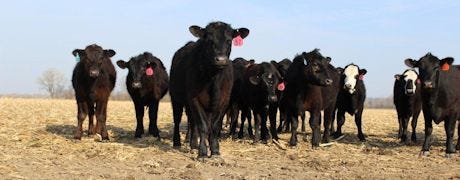
If you've stopped by the local meat counter lately, you've likely seen an increase in beef prices. USDA's Economic Research Service projects beef prices to rise 3% to 4% for 2014. One of the big drivers is a tight supply, which most producers are aware of, says Dr. Glynn Tonsor, associate professor of agricultural economics at Kansas State University. It also takes consumer demand, which has been strong. "We are asking consumers to pay historically high retail prices," Tonsor says. "Consumers that are willing and able, continue to be willing to pay the price."

BIOLOGICAL LAG: Heifer retention was up slightly in January 2014 over 2013, but Dr. Glynn Tonsor, associate professor of agricultural economics at KSU, says expansion takes time. "In the beef industry, you have this long biological lag, and it can take some time to see those benefits," he explains. "From when I decide to withhold a heifer and put her in the breeding herd, it's two-years before the industry benefits from it."
At the start of 2014, U.S. beef cattle numbers reached their lowest point since 1951. However, with higher cattle prices, stable or robust beef demand, and reduced input costs, the industry may be poised for expansion.
Reasons for optimism
Cow-calf: Cow-calf producers have the most justified optimism, Tonsor says. According to data from the Livestock Marketing Information Center in Denver, Colorado, annual returns per cow over cash costs are projected at $350 for 2014 and 2015. The previous highest returns were $130 and $150 for 2013 and 2004.
Every factor for cow-calf profit margins has improved, including lower input costs, higher calf prices, and for most producers, improved pasture management and carrying capacity. Heifer retention was up slightly in January 2014 over 2013, but it will take time to expand, Tonsor says. "In the beef industry, you have this long biological lag, and it can take some time to see those benefits," he explains. "From when I decide to withhold a heifer and put her in the breeding herd, it's two-years before the industry benefits from it."
Stocker: For those in the stocker business, the value of gain [VOG] compared to cost of gain [COG] looks attractive for 2014, as pasture conditions have improved and feed costs have decreased. For example, using Beef Basis forecasting tool, VOG consistently reaches $120 per cwt or higher from 550 to 650 pounds from February to April, and over $100 from 550 pounds in September to 750 pounds in December, or about two pounds per day. "Those are pretty attractive values of gain at a time when cost of gain for most stocker operations is coming down," he says.
~~~PAGE_BREAK_HERE~~~
Looking ahead toward expansion, Tonsor says stocker operations will likely need to put on more pounds – not necessarily by increasing end weight, but on the cow side, by pulling calves off sooner to reduce grazing pressure and make better use of forage. This will take cow-calf producers willing to bring in lighter calves.
Feeder cattle: Over the next few months, feeder cattle prices look stable, if not higher, due to tight supply and neutral, if not positive demand, he says. Closeouts from December 2013 through March 2014 have improved significantly. December returns were the first positive numbers since March 2012. January closeouts had a net return of $124.37, the highest since April 2011, mostly due to stronger fed cattle prices. "The feedlot industry has had a real rough go in the last couple of years," Tonsor says. "But things have improved a lot [in 2014]."
Excess capacity is a lingering issue, with a continued drop in feeder cattle numbers. Commercial slaughter numbers will continue to decline, and may be 6.5% lower by the end of 2014, mostly due to a low calf crop. Meanwhile, improved genetics and technology have helped put more pounds on each animal. "The more pounds we can put on per hoof is more per hook," Tonsor says. "We're not going to increase dress weights enough to offset [the decline]."
What can you do?
When it comes to expanding the herd, Tonsor encourages making use of available resources and decision making tools like Beef Basis or AgManager. Secondly, he encourages producers to know their comparative advantage, or the ability to produce at a lower cost than others, which decision tools help with. "Quite honestly not everybody has the same situation and opportunity to expand the herd," Tonsor says. "For some people it's a real good time to expand, for some people it's not."
He also encourages producers to consider doing something they didn't do last year. "I'm challenging you to recognize the world is changing and think about what it means to you," he says. "You don't have to change, but I think you will be better off if you stop and assess it." Finally, it's important to think globally, manage locally, and stay informed. "Lots of things happen in the global world, that you have no influence on, that drive profitability," he says. "I want you to be aware of it, but ultimately you have to focus on things you can influence."
About the Author(s)
You May Also Like






